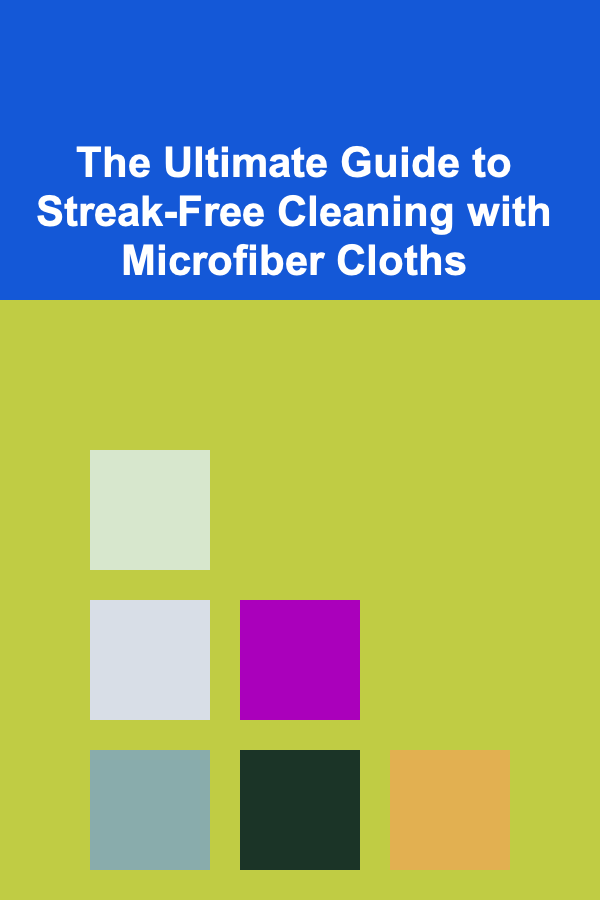
The Ultimate Guide to Streak-Free Cleaning with Microfiber Cloths
ebook include PDF & Audio bundle (Micro Guide)
$12.99$8.99
Limited Time Offer! Order within the next:

Microfiber cloths have revolutionized the cleaning industry. These seemingly simple textiles possess incredible cleaning power, capable of lifting dirt, dust, and grime without harsh chemicals, leaving surfaces sparkling and streak-free. However, unlocking their full potential requires understanding their properties, proper techniques, and consistent maintenance. This comprehensive guide will delve into the science behind microfiber, the optimal methods for using them, and the secrets to ensuring they remain effective and contribute to a cleaner, healthier environment.
Understanding the Science of Microfiber
To truly appreciate the power of microfiber cloths, it's crucial to understand their unique construction. Unlike traditional cotton cloths, microfiber is made from synthetic fibers, typically a blend of polyester and polyamide (nylon). These fibers are split into incredibly thin strands, often thinner than a strand of silk. This creates a vastly larger surface area compared to cotton, allowing microfiber to trap and hold significantly more dirt and debris.
- Fiber Size: Microfibers are typically less than one denier in diameter. Denier is a unit of measurement for the fineness of fibers; a single strand of silk is about one denier. Some microfiber cloths boast fibers as fine as 0.1 denier.
- Surface Area: The increased surface area provides millions of tiny hooks that grab onto dust, dirt, oil, and even bacteria. This is a mechanical cleaning process, relying on physical attraction rather than harsh chemicals.
- Capillary Action: The spaces between the fibers create capillary action, drawing liquids and spills into the cloth and preventing them from spreading. This is why microfiber cloths are so effective at absorbing water and other fluids.
- Positive Charge: Many microfiber cloths, especially those used for electronics, are designed with a slightly positive electrostatic charge. This helps attract negatively charged dust particles, further enhancing their cleaning capabilities.
This unique composition translates into several significant advantages over traditional cleaning methods:
- Superior Cleaning Power: Microfiber cloths remove more dirt and bacteria than cotton cloths. Studies have shown they can remove up to 99% of bacteria from surfaces, compared to around 30% for cotton.
- Chemical-Free Cleaning: Often, microfiber cloths can clean effectively with just water, reducing the need for harsh chemicals and promoting a more environmentally friendly cleaning routine.
- Lint-Free: Unlike cotton cloths, microfiber cloths are virtually lint-free, leaving surfaces clean and clear without leaving behind annoying fibers.
- Durability: High-quality microfiber cloths can withstand hundreds of washes, making them a cost-effective and sustainable cleaning solution.
Choosing the Right Microfiber Cloth for the Job
Not all microfiber cloths are created equal. Different weaves, thicknesses, and blends are designed for specific cleaning tasks. Selecting the right cloth ensures optimal performance and prevents damage to delicate surfaces.
Types of Microfiber Cloths:
- General Purpose Cloths: These are typically a blend of 80% polyester and 20% polyamide and are suitable for a wide range of cleaning tasks, including dusting, wiping countertops, and cleaning windows. They often have a terry weave.
- Glass and Window Cloths: These cloths are designed with a tighter weave and a smooth surface to minimize streaks. They often have a lower polyamide content (e.g., 90% polyester, 10% polyamide) or a split weave to ensure streak-free results. Sometimes called "suede" microfiber.
- Polishing Cloths: These cloths have a very soft, plush pile and are designed for polishing surfaces like car paint, furniture, and stainless steel. They are often made with a higher polyamide content to increase absorbency and softness.
- Mop Heads: Microfiber mop heads are extremely effective at cleaning floors. They can be used wet or dry and are available in a variety of shapes and sizes to fit different mop handles.
- Applicator Pads: These pads are designed for applying waxes, polishes, and sealants. They typically have a loop or terry weave for even distribution.
- Electronics Cleaning Cloths: These are often very fine and tightly woven to prevent scratching delicate screens. They often come pre-treated with an anti-static solution.
Factors to Consider:
- GSM (Grams per Square Meter): This measures the density of the microfiber. Higher GSM cloths are thicker, more absorbent, and generally better for heavy-duty cleaning. Lower GSM cloths are thinner and better for delicate surfaces.
- Pile: The pile refers to the height of the fibers. A longer pile is better for trapping dirt and dust, while a shorter pile is better for polishing and leaving a smooth finish.
- Blend: The ratio of polyester to polyamide affects the cloth's absorbency and softness. Higher polyamide content generally means greater absorbency and a softer feel.
- Weave: Different weaves, such as terry, waffle, and split weave, provide different cleaning characteristics.
Tip: Keep a variety of microfiber cloths on hand for different cleaning tasks. Label them clearly to avoid cross-contamination.
Mastering the Technique: Step-by-Step Guide to Streak-Free Cleaning
Even with the best microfiber cloths, proper technique is essential for achieving streak-free results. Here's a step-by-step guide to maximize their cleaning power:
1. Preparation:
- Dust or Vacuum First: Before wiping any surface, remove loose dirt and debris with a duster, vacuum, or broom. This prevents the microfiber cloth from simply pushing the dirt around.
- Choose the Right Cloth: Select the appropriate microfiber cloth based on the surface you're cleaning (e.g., a glass cloth for windows, a general-purpose cloth for countertops).
- Prepare Your Cleaning Solution (Optional): While microfiber cloths can often clean with just water, you can use a gentle cleaning solution for tougher grime. Avoid harsh chemicals like bleach or strong detergents, as they can damage the fibers and reduce their effectiveness. A simple solution of water and a few drops of dish soap or vinegar works well. For glass, consider a dedicated glass cleaner.
- Dampen the Cloth: The key to streak-free cleaning is using a damp microfiber cloth, not a soaking wet one. Too much water will leave streaks. Wring out the cloth thoroughly until it feels only slightly damp.
2. The Cleaning Process:
- Fold the Cloth: Fold the microfiber cloth into quarters. This provides multiple clean surfaces and allows you to use the cloth more efficiently.
- Wipe in S-Shaped Motions: Use overlapping S-shaped motions to wipe the surface. This ensures complete coverage and prevents streaks.
- Apply Gentle Pressure: Apply gentle pressure while wiping. Let the microfiber cloth do the work. Excessive pressure can scratch delicate surfaces.
- Flip and Fold: As one section of the cloth becomes soiled, flip it over to a clean side. Once all four sides are used, refold the cloth to reveal a fresh surface.
- Rinse and Wring (If Necessary): If the cloth becomes heavily soiled during the cleaning process, rinse it thoroughly under running water and wring it out completely before continuing.
- Dry Buff (For Glass and Shiny Surfaces): After wiping with a damp microfiber cloth, use a clean, dry microfiber cloth to buff the surface. This removes any remaining moisture and polishes the surface for a streak-free shine.
3. Specific Surface Techniques:
- Glass and Mirrors: Use a dedicated glass microfiber cloth. Dampen the cloth with water or a glass cleaner. Wipe the surface in overlapping S-shaped motions. Follow with a dry microfiber cloth to buff.
- Stainless Steel: Wipe in the direction of the grain to avoid scratches. Use a slightly damp microfiber cloth and follow with a dry cloth to polish.
- Wood Furniture: Dust regularly with a dry microfiber cloth. For cleaning, use a slightly damp cloth and a wood cleaner specifically designed for your furniture's finish. Always test the cleaner in an inconspicuous area first.
- Electronics Screens: Use a dry, static-free microfiber cloth specifically designed for electronics. Gently wipe the screen to remove dust and fingerprints. Avoid using liquids, as they can damage the screen.
- Countertops: Use a general-purpose microfiber cloth. Wipe with a damp cloth and a cleaning solution appropriate for your countertop material (e.g., granite cleaner for granite, all-purpose cleaner for laminate).
Tip: Avoid using fabric softener when washing microfiber cloths, as it can coat the fibers and reduce their absorbency and cleaning power.
Maintaining Your Microfiber Cloths: Ensuring Longevity and Effectiveness
Proper care and maintenance are essential to extend the life of your microfiber cloths and maintain their cleaning effectiveness. Neglecting these steps can lead to reduced absorbency, decreased cleaning power, and even damage to the fibers.
Washing Microfiber Cloths:
- Wash Separately: Wash microfiber cloths separately from other fabrics, especially cotton. Cotton fibers can become trapped in the microfiber, reducing its cleaning power.
- Use a Mild Detergent: Use a mild, liquid detergent. Avoid detergents with added perfumes, dyes, or fabric softeners. Powdered detergents can leave residue on the fibers.
- Avoid Fabric Softener: Fabric softener coats the fibers and reduces their absorbency. It's best to avoid it altogether.
- Wash in Warm Water: Wash in warm water (not hot) to avoid damaging the fibers.
- Rinse Thoroughly: Ensure the cloths are rinsed thoroughly to remove all traces of detergent.
- Air Dry or Tumble Dry on Low: Air drying is the best option, as it prevents the fibers from melting or becoming damaged. If using a dryer, tumble dry on low heat. Avoid using dryer sheets, as they contain fabric softener.
Other Maintenance Tips:
- Pre-treat Stains: For stubborn stains, pre-treat the cloth with a stain remover or a mixture of baking soda and water.
- Don't Use Bleach: Bleach can damage the fibers and reduce their effectiveness.
- Avoid Ironing: Ironing can melt or damage the synthetic fibers.
- Store Properly: Store clean, dry microfiber cloths in a clean, dry place. Avoid storing them with other cleaning supplies that may contaminate them.
- Replace Regularly: Even with proper care, microfiber cloths will eventually wear out. Replace them when they start to lose their absorbency or cleaning power. A good rule of thumb is to replace heavily used cloths every 6-12 months.
Tip: If your microfiber cloths start to lose their absorbency, try washing them with a cup of white vinegar. Vinegar helps to remove any residue that may be coating the fibers.
Troubleshooting Common Issues with Microfiber Cloths
Even with careful technique and maintenance, you might encounter some common issues when using microfiber cloths. Here's how to troubleshoot them:
- Streaks:
- Cause: Too much water, dirty cloth, wrong type of cloth.
- Solution: Wring out the cloth more thoroughly, use a clean cloth, switch to a glass-specific microfiber cloth, dry buff the surface.
- Lint:
- Cause: Washing with cotton fabrics, low-quality microfiber cloth.
- Solution: Wash microfiber cloths separately, invest in higher-quality microfiber cloths.
- Reduced Absorbency:
- Cause: Fabric softener build-up, detergent residue.
- Solution: Wash with white vinegar, use a mild detergent, rinse thoroughly.
- Smell:
- Cause: Trapped bacteria or mildew.
- Solution: Wash with hot water and a small amount of bleach (use sparingly and only if necessary), air dry thoroughly.
- Scratching:
- Cause: Dirty cloth, using too much pressure, wrong type of cloth.
- Solution: Always use a clean cloth, apply gentle pressure, use a softer microfiber cloth designed for delicate surfaces.
Environmental Benefits of Using Microfiber Cloths
Beyond their superior cleaning performance, microfiber cloths offer significant environmental benefits:
- Reduced Chemical Use: Microfiber cloths often require little to no cleaning solutions, reducing the amount of harmful chemicals released into the environment.
- Less Paper Towel Waste: By replacing paper towels with reusable microfiber cloths, you can significantly reduce paper waste.
- Durability and Longevity: High-quality microfiber cloths can last for hundreds of washes, making them a more sustainable option than disposable cleaning products.
- Reduced Water Consumption (Potentially): While washing microfiber cloths does require water, the overall water consumption can be lower compared to the water used to manufacture paper towels.
By embracing microfiber cloths and adopting proper cleaning techniques, you can create a cleaner, healthier home and contribute to a more sustainable future.
Beyond Cleaning: Other Uses for Microfiber Cloths
The versatility of microfiber extends beyond just cleaning. Here are some other creative and practical uses:
- Cosmetic Removal: Soft microfiber cloths are excellent for removing makeup gently and effectively.
- Dusting Plants: Use a damp microfiber cloth to gently wipe the leaves of your houseplants, removing dust and allowing them to absorb more sunlight.
- Pet Care: Use a damp microfiber cloth to wipe down your pet's paws after a walk or to remove loose fur.
- Car Detailing: Microfiber cloths are essential for car detailing, from washing and waxing to polishing and drying.
- Photography and Optics: Use a specialized microfiber cloth designed for lenses to clean camera lenses, eyeglasses, and other optical equipment.
Conclusion: Embracing the Power of Microfiber
Microfiber cloths are more than just cleaning tools; they are an investment in a cleaner, healthier, and more sustainable lifestyle. By understanding the science behind their effectiveness, choosing the right cloths for specific tasks, mastering proper cleaning techniques, and maintaining them diligently, you can unlock their full potential and enjoy streak-free cleaning for years to come. Embrace the power of microfiber and experience the difference it can make in your home and in the world.

How to Explore Different Cultures Through Food Nights
Read More
How to Host an Unforgettable Game Day Party at Home
Read More
How to Use Whiteboards and Chalkboards for Organization
Read More
How to Design Earthquake-Resistant Steel Structures
Read More
10 Tips for Brand Manager Career Advancement
Read More
10 Tips for a Job Application Checklist for Executive Roles
Read MoreOther Products

How to Explore Different Cultures Through Food Nights
Read More
How to Host an Unforgettable Game Day Party at Home
Read More
How to Use Whiteboards and Chalkboards for Organization
Read More
How to Design Earthquake-Resistant Steel Structures
Read More
10 Tips for Brand Manager Career Advancement
Read More